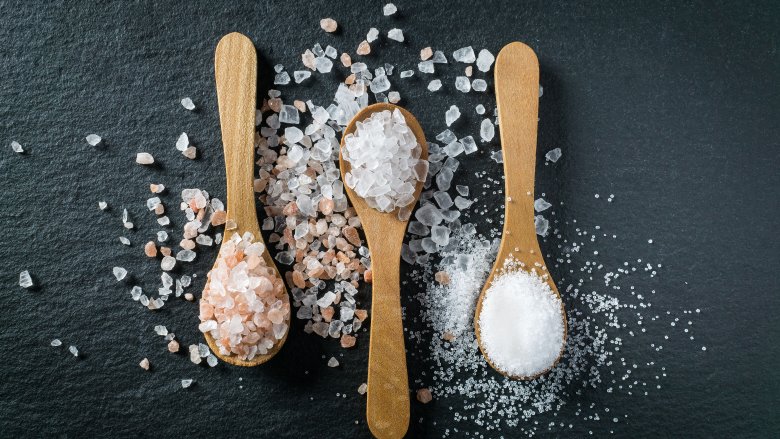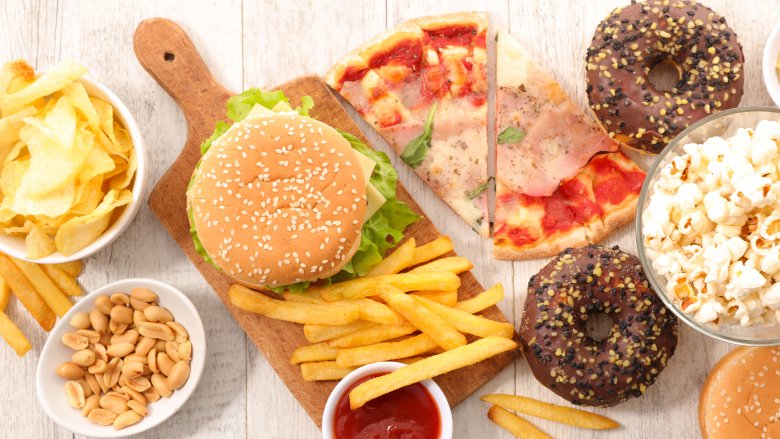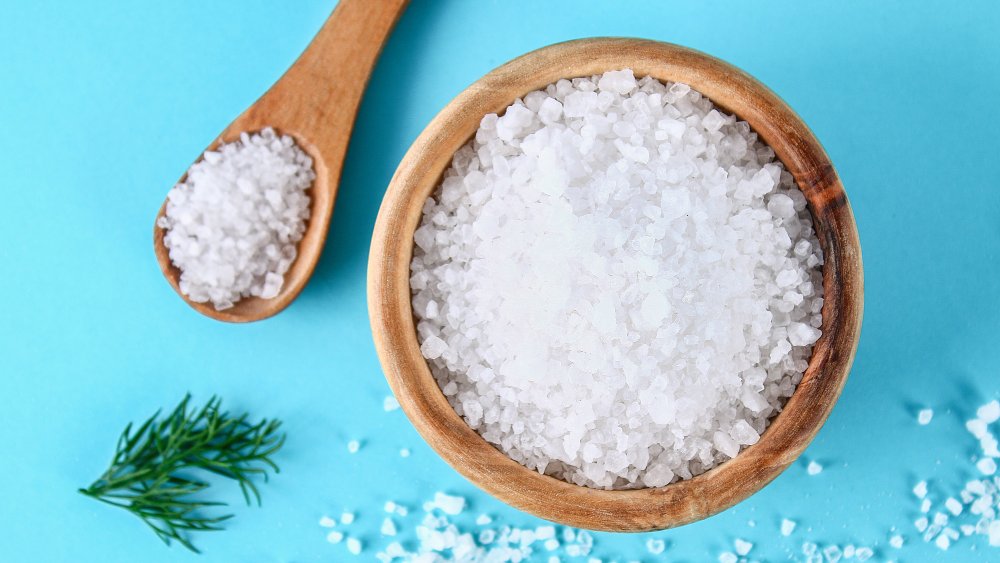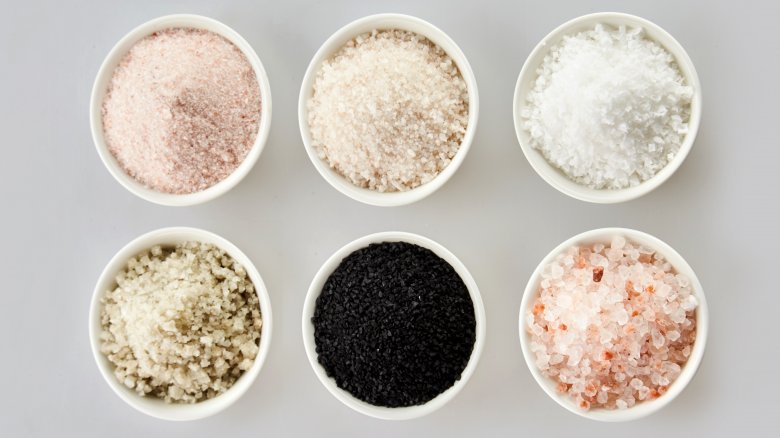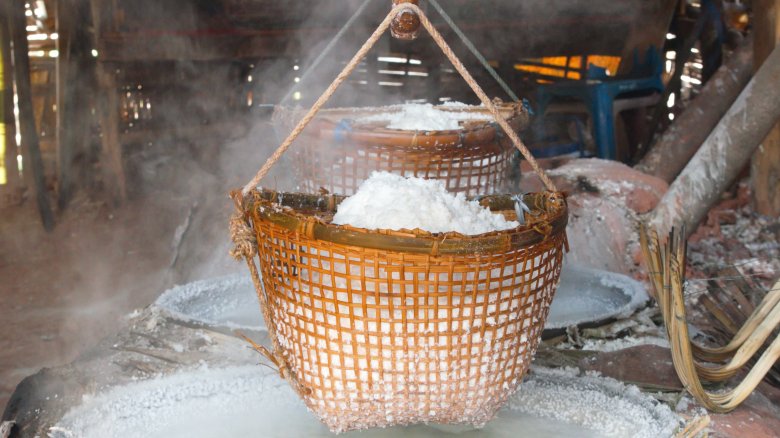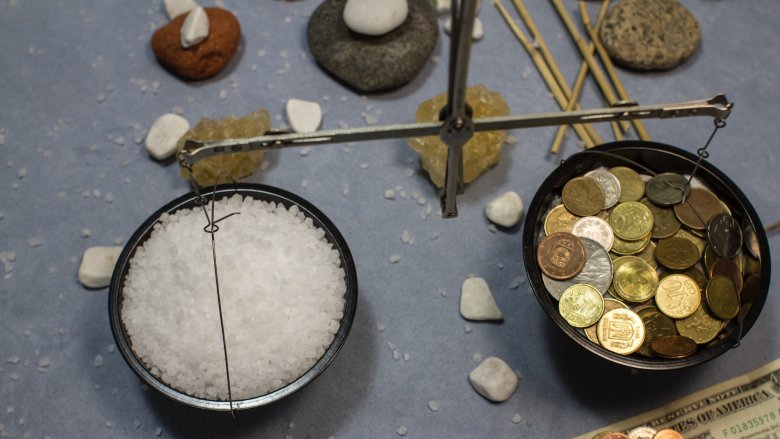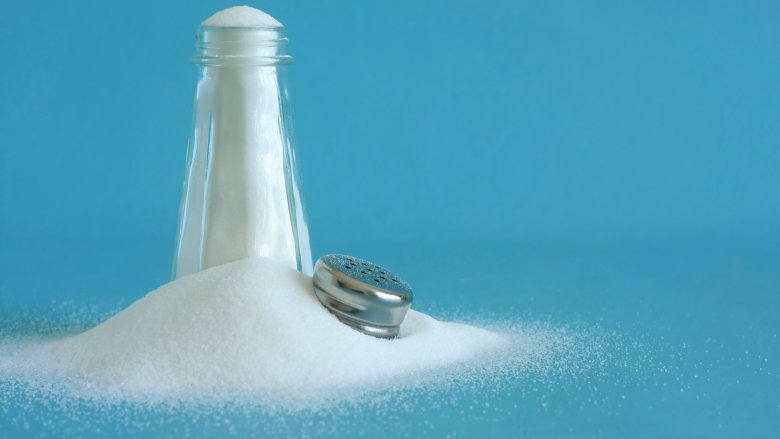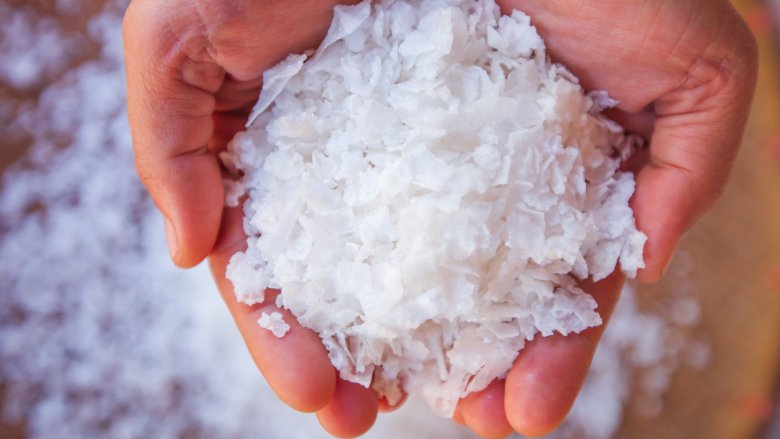The Untold Truth Of Salt
Salt is everywhere. Even if you can't taste it, chances are good it's in everything from your breakfast oatmeal to the salad you brought for lunch. According to the FDA, Americans eat on average 3,400 milligrams of sodium, a chemical element found in salt, each day (over 1,000 milligrams more than the daily recommended value, the equivalent of one teaspoon). Salt consumption has gotten out of control, turning from a way to preserve food into a cheap commodity used to flavor our favorite salty snacks. It's so inexpensive that you probably don't think twice about the price tag of a box at the store (unless you're opting for a bottle of the expensive pink Himalayan salt).
It wasn't always that way, though. Salt has been around for thousands of years, and it was once so valuable that people traded it ounce-per-ounce with gold. Wars were fought over it, and it inspired a lively black market throughout Europe and Asia. There's even a way that salt might bring you good luck. So how did such a valuable product become the mass-produced product that we haphazardly add to food, one pinch at a time? You might be surprised to find out some of these lesser-known facts about everyone's favorite seasoning, salt.
Without salt, we would die
Part of the reason we crave salty snacks is because our cells need salt to function. Every single cell in our bodies contains salt in the form of ions. These charged particles become the electricity that powers our cells to perform whichever essential function they're designed to do, like converting nutrients into energy. Because our bodies are continually losing salts when we sweat or use the restroom, we need to replenish the supply of salts through our diet constantly.
Like all things, salt should be used in moderation. Overeating salt can be harmful to your health and many dietitians recommend reducing salt intake to lower blood pressure and improve heart health. You wouldn't want to reduce salt intake too much, though. If our body's sodium level falls below normal, you can die from hyponatremia, insufficient sodium in the blood. It may also lead to an increased risk of insulin resistance, increased risk of death from heart failure, and an increase in LDL cholesterol and triglycerides.
You're probably eating too much salt
Your body might need salt to function, but it doesn't need that much. Healthline estimates our bodies only need 186 milligrams each day — that's less than what fits in a tenth of a teaspoon. Unfortunately, consuming such a small amount of sodium is close to impossible since salt is in almost everything we eat and drink. Various health organizations suggest a daily maximum of 1.5 to 2.3 grams to prevent health concerns like high blood pressure, but we eat way more than that. The Harvard School of Public Health estimates most Americans consume 3.4 grams (or 1.5 teaspoons) of sodium per day. If you're in that group, that means you're eating 18 times more salt than your body needs to function!
It's not so easy to cut back on salt intake, either. The American Heart Association warns consumers that the sodium in our diet isn't actually coming from the salt shaker. As much as 70 percent comes from packaged or restaurant food, which makes it hard to know the actual amount of salt you put into your body. The best way to cut back is to skip the pre-made, boxed, or bagged food and try to prepare your own meals from fresh meats, grains, and produce.
Salt might just raise the world's IQ
It's a wild claim, to think that something as common as salt might be able to make the world a smarter place, but according to The New York Times, it's entirely possible.
The reason is iodine. According to Healthline, around a third of the world's population teeters on the brink of an iodine deficiency. What does that mean? Not only does iodine keep our thyroid functioning properly, but it's also crucial for healthy and normal brain function.
And here's where intelligence comes in. Among those at the highest risk for iodine deficiency are pregnant women, and studies suggest that iodine-deficient women who give birth will likely have a child with an IQ between 10 and 15 points lower than she would have had if sufficient levels of iodine were included in her diet.
Given that one of the most common sources of iodine is iodized salt, it's a deficiency that's easily preventable — with a little salt and a lot of education. In 1990, the World Summit for Children pushed for a campaign championing the benefits of iodized salt, and it got real results. Take Kazakhstan, for example. In the 1990s, they were one of the most iodine-deficient countries in the world, with as many as 10 percent of their children suffering from stunted growth and developmental difficulties. By 2006, they had increased the usage of iodized salt and were looking forward to a United Nations declaration that they were free of iodine deficiency disorders.
There are different kinds of salt, but one isn't healthier than another
There are all kinds of different salts. The mineral mixes can vary depending on where salt is harvested, and there are various methods of processing salt. According to Tasting Table, the variety of sea salts is almost endless because you can produce salt from anywhere there is saltwater. Water from 2,200 feet off the Hawaiian coastline creates Kona deep water sea salt, and salt mined in the Punjab region of Pakistan turns pink from trace amounts of iron oxide, creating Himilayan sea salt.
Although each type of salt has a different flavor (especially those blended with seasonings like truffles), they all have a similar sodium content. Unfortunately, most people don't know that one type of salt isn't healthier than another. In a 2011 American Heart Association survey, 61 percent of the 1,000 people surveyed thought that sea salt is a low-sodium alternative to table salt. It's true that kosher salt and some sea salts do contain less sodium by volume because their flakes are larger in size than table salt. But, table salt and most sea salts contain the same amount of sodium by weight: 40 percent. So go ahead and use sea salt if you like the flavor, but it won't actually be any healthier than regular salt.
There are different ways we get salt
If you've ever seen the words "rock salt" and "sea salt" on packages, it's because they're technically two different products. Sea salt is made from evaporated salt water. According to Morton Salt, the oldest way to produce salt involves capturing sea water in shallow ponds. The sun evaporates most of the water to create a concentrated brine. Eventually, all the water evaporates, leaving crystallized salt behind. Today, some salt producers force the process by using commercial equipment called vacuum pans. The concentrated saltwater brine is boiled under pressure, creating a high-quality, finely textured salt.
Rock salt, on the other hand, doesn't involve any water at all. Salt also grows thousands of feet below the earth in underground mines. Miners access the salt via mineshafts, drill holes, and blast the rock salt out of the walls using explosives. From there, the salt is crushed and sorted. Is there a difference between the two products? A little: Sea salt contains more trace minerals, and rock salt is sometimes gray in color due to impurities in the rock. Some people say that rock salt has a more concentrated flavor, too.
The number one use for salt isn't for food
When you think of salt, you probably think of food, right? And considering how many cured meats and processed foods fill our grocery store shelves, you might assume the number one use for salt is for food production. It turns out there are numerous uses for salt, from removing ice from your sidewalk in the winter, to manufacturing lye, another name for the lye used to make candles, soap, and drain cleaner. According to the United States Geological Survey (USGS) Minerals Information, agricultural and food processing was only responsible for 3 percent of all salt use in 2018. What took the number one spot? Highway deicing, which uses 43 percent of the salt consumed each year.
Salt is an extremely effective deicing agent because it lowers the freezing point of water. Instead of the water freezing at the regular temperature of 32 degrees Fahrenheit, adding a 10 percent salt solution changes the freezing point to 20 degrees. Or, use a 20 percent salt solution and water won't freeze above 2 degrees. Unfortunately, salting roads isn't without environmental impact — it leaches minerals like sodium, chlorine, lead, iron, aluminum, and phosphorus into the ground — but it is the most cost-effective deicer available.
Salt was once used as currency
Have you ever heard the saying that someone is "not worth one's salt?" That's because salt was once so valuable, it was used as currency. Before refrigeration, salt was the only way to preserve food, and anyone without it couldn't travel to new lands without their food spoiling. In ancient Rome, soldiers were often paid in salt (or, given an allowance with which to purchase salt). The word "salary" even comes from the Latin word for salt, sal. So, if a soldier was doing a lousy job, his paycheck would be cut because he wouldn't be worth his salt.
Salt as a currency isn't restricted to ancient times, either. According to a 1962 article in the Journal de la Société des Africanistes, Ethiopians used "primitive money" for a millennium and a half. The main form of currency was salt, and it was said that "whoever carries it finds all that he requires." Using axes, the salt was cut into large blocks called amole and carried by donkey caravan across the country. If a block broke in transit, it lost value. This practice continued into the 20th century in some remote areas. Even today, Maldon Salt Company suggests taking a pack of salt into the country if you visit, in case of emergencies.
Leonardo da Vinci might be responsible for superstition that spilling salt is bad luck
If you're superstitious, you may think it's bad luck to spill salt. If you do, legend dictates that you're supposed to pick up a pinch and toss it over your left shoulder to prevent the bad luck from following you around. Where did this fear come from? Some believe that it came from ancient times when salt was very expensive. Anyone who wasted such a precious commodity was branded as bad luck to motivate people to be more careful with their salt use.
That may be the answer, but it could also be Leonardo da Vinci's fault. In his "The Last Supper" painting, you'll see a container of spilled salt at Judas Iscariot's elbow. Because it's so close to his arm, one can assume that Judas accidentally knocked the vessel over at some point during the dinner. The Bible describes how Judas went on to betray Jesus after this dinner, so salt-spilling became associated with dishonesty, treachery, and bad fortune.
An inventor made millions by selling a salt gun
Although it's no longer used as currency or to pay our salaries, salt is still big business today. Table salt might be cheap, but pink Himilayan salts are up to 20 times more expensive (and that bright pink color is oh-so-Instagramable). It's not just for eating, either; Himilayan salt glow lamps were trending on Amazon for a long time, and there's a hotel in Bolivia that is built with salt. According to Livabl, it took one million, 14-inch blocks of compressed salt to make it happen!
One of the most impressive salt-related product is the Bug-A-Salt gun. Lorenzo Maggiore always had the idea to make a gun to kill flies. CNBC reports that when he did, he became a millionaire. The gun uses ordinary table salt as its "ammo," spraying granules of salt at a fly to safely remove it from your dining room table. The Indiegogo campaign for the product received over $500,000 in funding, and in 2018 the company reached revenues of $27 million. It's a pretty impressive use for regular old table salt!
New York City led the charge for restricting salt use
New York City has had some pretty edgy restaurant bans over the years. They prohibited restaurants from using trans fats in 2006, and they were the first city in the nation to require chain restaurants to post calorie counts on their menu boards. So, no one should have been surprised when The New York Times reported in 2010 that then-mayor Michael Bloomberg rolled out the National Salt Reduction Initiative (NSRI). This voluntary plan called for companies to reduce the sodium content in their food by 25 percent over five years, gradually pulling salt away so "the change is not so noticeable to consumers."
In 2016, the New York City Health Department reported the program was successful in reducing sodium levels by about 7 percent in a sample of top-selling packaged foods. The success led to a new campaign aimed to educate the public with a sodium warning icon. These warnings would appear on restaurant chain menus when a menu item has sodium content higher than 2,300 milligrams, the total daily recommended limit. Sounds good to us; who wants to eat an entire day's worth of salt in one sitting?
Salting the corners of your house might bring you good luck, peace, and prosperity
Throughout history, salt played a role in many religions to purify objects or repel evil. In Buddhist tradition, salt is used to repel evil spirits, and they're known to throw salt over their shoulders after funerals to make sure evil spirits didn't follow them home. The Shinto religion also used salt to purify an area, which is why salt is thrown into the center of the ring before sumo wrestling matches: to remove malevolent spirits.
Want to use salt to purify your own home? According to Bright Side, pouring salt in the corners of your house will bring you good luck, peace, and prosperity. They suggest performing an easy salt ritual that involves standing in the middle of your room, picking up handfuls of salt, and spraying it in the corners of the room moving in a clockwise direction. This drives away negative energy, purifying and protecting your home. It's worth a try right?

